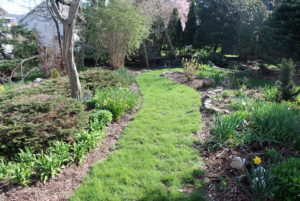Two Weeks Behind
May 1st, 2018
So here we are at the beginning of May, and I’m just now cutting my grass for the first time.
I can’t ever remember the grass lagging this long into spring. Then again, I don’t remember a lot of things as well as I used to.
The cool April has the whole landscape moving in slow motion, waiting for some sustained warmth before growth kicks into its usual healthy mid-spring pace.
I’d estimate we’re running about two weeks behind.
The good news is that the steady cool is prolonging the early-spring bulbs and the early-blooming trees and shrubs, such as forsythia, saucer magnolia, and ornamental pear.
Soil moisture also has been good, and we haven’t had any erratic warmups followed by sudden freezes – a duo that lures buds into a death trap. Consistency either way (unusually cool or unusually warm) is far better for plants than yo-yo weather.
What concerns me a little, though, is that we’re going to catch up too fast. If the weather goes back to normal or even warmer than normal, plants will fast-forward back to their regularly scheduled programming.
That would mean a compacted late spring.
One result could be blooms that come and go faster than usual. In other words, don’t blink or you’ll miss the lilacs.
The other possibility is having plants flower together instead of following one after the other in a symphony of bloom. That can be more impressive than usual, but it also tightens our ogling and sniffing pleasure into a shorter package.
The worst scenario is if the weather decides to go right into July mode, cheating us out of some of our finest weather weeks of the year.
Oh, well. There’s not much we can do about any of that anyway.
We get what we get. And gardeners quickly learn to roll with whatever.
One thing you don’t want to do now is get impatient and dig up plants that aren’t really dead. The cool start not only has slowed grass growth and delayed blooming, it’s delayed perennials from pushing up new growth and delayed woody plants from pushing out new leaves and branches.
Maybe some of the non-growth you’re seeing really is due to winter death. But I suspect most of it is plants that are still dormant – especially late-to-get-started species such as hardy hibiscus, crape myrtle, figs, and butterfly bush.
Winter dieback most often happens on plants that are borderline-hardy in our winters (osmanthus, crape myrtle, and camellia, for example) and on new plants that haven’t had a chance to fully root or that weren’t properly watered heading into winter.
In each of the above cases, the solution is patience.
For broadleaf evergreens and conifers that suffered browned or dropped leaves/needles, do nothing. Wait and give them a chance to grow new foliage. In a few weeks, they’ll likely be as good as new.
Plants that suffered branch diebacks as opposed to complete death also will push out new foliage growth in the coming weeks.
The difference is that the new growth may come only from lower and inside the plants but not toward the top and branch tips. If that happens, just cut back the dead wood to where you’re seeing new growth occur.
Some shrubs may have died back the whole way to the ground but will send up new shoots from around the base. This is because cold killed all of the top growth but not the roots.
Live roots mean the plant has a good shot at fully recovering, although you’ll be starting all over when it comes to size and form.
Just about everything that’s going to come back will be showing growth by the end of May. That used to be my dead-or-not cutoff date.
But a few years ago after a harsh winter and a slow spring, some plants didn’t begin growing until June. I even had a fig that I was sure was dead that finally sprouted new shoots at the beginning of July.
So if you really want to be sure, I’d wait at least a few weeks into June before digging.
In the meantime, there are two tests you can do to determine if a woody plant is dead or just still dormant.
One is to scratch off some of the bark. If the wood underneath is brown instead of green, that branch is dead. That doesn’t mean the whole plant is dead… just what you tested. The prognosis is grimmer if you’re getting brown everywhere you scratch.
The second test is to try bending a few branches. If the branches/twigs are snapping instead of bending, those branches are dead.
There’s really nothing you can do about dead wood at this point, other than cut it back to live wood… or even the whole way to the ground in the case of a plant that’s died back to the roots.
Be patient, though. Plants may surprise you with their resilience.









